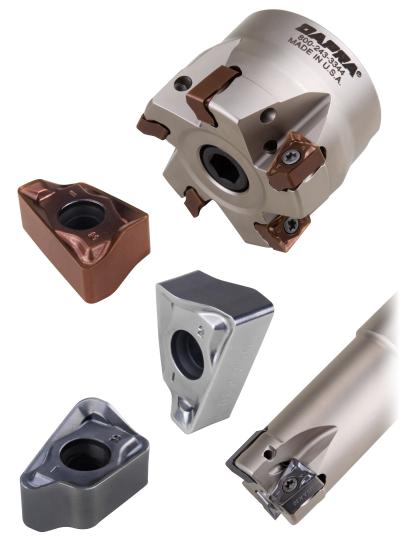
The new EDGE2 DSS system from DAPRA Corp. was engineered to deliver both premium 90° milling performance and indexable milling value. Double-sided DSS inserts provide four usable cutting edges to significantly lower cost-per-edge versus single-sided inserts, and DAPRA’s permanent automatic cutter replacement program makes it easier for shops to keep good-condition tools in use rather than making do with worn-out cutters.
DSS inserts feature a positive geometry for low cutting pressure while still maintaining strength. Designed convexity creates smooth surface finishes when step-down profile milling, and a custom-designed wiper edge generates fine surface finishes. They are available in both T-land and dished geometries, in a variety of high-performance grades and coatings.
DSS endmills, shell mills and screw-on modular heads are machined from hardened, high-shock tool steel to minimize runout and maximize durability and life. Nickel plating provides a harder casing for improved pocket durability and resistance to chip galling, and deep gullets deliver efficient chip evacuation, even on the heaviest cuts. Long-reach tools are available with carbide core for enhanced rigidity and reduced deflection.
DSS system tools will be available in late November.
Contact Details
Related Glossary Terms
- galling
galling
Condition whereby excessive friction between high spots results in localized welding with subsequent spalling and further roughening of the rubbing surface(s) of one or both of two mating parts.
- gang cutting ( milling)
gang cutting ( milling)
Machining with several cutters mounted on a single arbor, generally for simultaneous cutting.
- milling
milling
Machining operation in which metal or other material is removed by applying power to a rotating cutter. In vertical milling, the cutting tool is mounted vertically on the spindle. In horizontal milling, the cutting tool is mounted horizontally, either directly on the spindle or on an arbor. Horizontal milling is further broken down into conventional milling, where the cutter rotates opposite the direction of feed, or “up” into the workpiece; and climb milling, where the cutter rotates in the direction of feed, or “down” into the workpiece. Milling operations include plane or surface milling, endmilling, facemilling, angle milling, form milling and profiling.
- wiper
wiper
Metal-removing edge on the face of a cutter that travels in a plane perpendicular to the axis. It is the edge that sweeps the machined surface. The flat should be as wide as the feed per revolution of the cutter. This allows any given insert to wipe the entire workpiece surface and impart a fine surface finish at a high feed rate.
